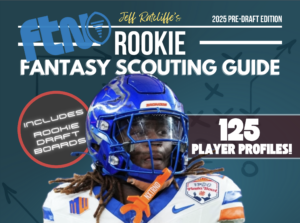
Fantasy football draft strategy doesn’t need to be complex. The goal on draft day is simple: to out-draft your opponents and put together the best team possible. While there’s certainly a lot to think about in a fantasy draft, there are a few key things to keep in mind as we head into the heart of fantasy football draft season. Here are five tips to help you dominate your 2022 fantasy football drafts.
Of course, don’t forget that you can check out all of our fantasy football rankings and fantasy football projections. Rankings are included as part of our Platinum Subscription. Along with rankings and projections, you’ll also get access to our Fantasy Football Game Plan Draft Guide and much more. Promo Code “RATPACK” will get you 20% off on any purchase.
1. Keep It Simple on Draft Day
A lot of folks show up to their drafts with binders of material or have multiple spreadsheets and tabs open on their laptops. Simply put, this is information overload, and you really don’t need it all to make your picks. Sure, all of this info is important right now as you prep for your drafts, but more inputs on draft day can lead you to paralysis from over analysis.
Put the work in beforehand, but keep it as streamlined as possible on draft day. I highly recommend checking out my 2022 fantasy football draft board, which can be found in the FTN Fantasy Football Game Plan Draft Guide. On this single sheet, you have every piece of information you need to make the best decision possible on each one of your picks. You won’t need to flip through pages or go back and forth between apps in your laptop. That means you’re less likely to panic pick, and you’ll more time to focus on exploiting your opponents’ mistakes on draft day.
2. Don’t Lock into Positions Early in Drafts
One of the most common questions I get at this time of year goes something like this: “Should I draft a running back in the first round and a wideout in the second?” The idea here is that the drafter is locking themselves into a position in a specific round. And hey, I get the thought process. You’re taking a position-based approach to building your roster. While this logic certainly comes into play later in your drafts, this method really limits what you can do in the early rounds.
Simply put, we don’t want to go after particular positions in specific rounds. Rather, the goal is to draft the best possible players. Sure, that’s somewhat of a “duh” statement, but many fantasy drafters overlook this objective and instead lock themselves into specific positions. However, each draft presents its own set of opportunities. Mock draft as much as you want, but you’re not going to be able to precisely predict what plays out on your actual draft day.
Remember, that while you are drafting your team, you’re also drafting against your opponents in your league. This is another example of stating the obvious that so often gets overlooked by drafters. The object isn’t just to win your league, it’s to win every phase of the game, including the draft. So, if your opponent makes a mistake and lets value slip down the board, make them pay for it. Of course, you won’t always be able to do so if you lock yourself into positions early in the draft. Instead, opt for a more flexible approach where your goal is to attack the early rounds and select the top players on your board regard less of position.
3. Punt Your RB2 Spot
Given how drafts are unfolding, it’s likely you’re going to end up with a running back in the first round. However, the value falls off very quickly at the position, and the top-end players have essentially dried up halfway through the second round. Unlike running back, wideout is deep this year. Better yet, because running backs go early and often, good wide receivers get pushed down the board. There’s a very good chance you’ll be able to score a top-five wideout in the second round and a top-10 fantasy wide receiver in the third. That’s a WR1 at a solid discount.
Don’t be afraid to take what the board is giving you. Let’s say you go running back in the first round and then score some value with CeeDee Lamb in the second. When you’re up in the third round, Tyreek Hill is still on the board. That’s value. Take him. Now the fourth round rolls around and Keenan Allen is sitting there on a silver platter. Sure, you only have one running back, but you just can’t pass this up. Take him. On to the fifth round, where Brandin Cooks is on the board at your pick. Your league just keeps handing you wide receiver value. Take him.
OK, so you might think you’re in a bit of a pickle, and you certainly could be drafting outside of your comfort zone with just one running back through the first five rounds. It certainly isn’t a conventional approach, but your team is absolutely loaded at wideout. The board presented you with value and you took it. In the process, you kicked off a Punt RB2 approach.
This isn’t a strategy I’d go into a draft planning to use, but it is one you should be prepared to use if the draft presents the opportunity. If you do go down this path, be prepared to absolutely hammer running back starting in the sixth round. Your goal should still be to have four running backs by the start of the double-digit rounds. That means running backs in three of the next four rounds. With these picks, shoot for higher-ceiling options to set yourself up for the most success.
4. Prioritize Tight End, But Don’t Go Overboard
Travis Kelce is very good. The Chiefs tight end is in the midst of a historic stretch where he’s finished as the No. 1 fantasy tight end in four of the last five seasons. But in order to draft him, you’re likely going to have to pony up a late first-round pick. While that certainly isn’t an outrageous price tag for him, it puts you into a potential conundrum from a roster construction standpoint. Likewise, you’re probably also going to see Mark Andrews and Kyle Pitts come off the board by the end of the second round.
There’s no denying the fantasy prowess of the Big 3 tight ends, but as someone like Andrews showed us last year, middle-round players are capable of making the leap into fantasy elite territory. In other words, you didn’t have to spend a premium pick on him. Instead, you were able to use your early picks to load up at wideout and running back.
To be fair, waiting that long always comes with volatility this year given the overall depth at the position. However, there’s a very interesting wheelhouse of value between the fifth and eighth rounds. In this phase of your drafts, you’re likely to see T.J. Hockenson, Dalton Schultz and Dallas Goedert come off the board. Any one of these three players could finish as a top-three guy, but you won’t have to pay a top-three price for them. And if you miss on that bunch, you can always shoot for upside in the early double-digit rounds with Evan Engram, Gerald Everett, David Njoku or Irv Smith.
5. Wait Until the End of Your Draft to Draft a Quarterback
Seriously. Even in your home leagues where quarterbacks come off the board early, you can wait. You don’t need Josh Allen or Patrick Mahomes to win your leagues this year, and the reason is relatively simple. The annual difference between the top fantasy quarterbacks and the best player you can get off waivers is much slimmer than what you’ll find at running back or wide receiver.
Don’t believe me? The difference between last year’s No. 2 quarterback, Tom Brady, and the likely replacement range of Matt Ryan at No. 18 was 152 fantasy points. Let’s compare that to running back where Austin Ekeler at No. 2 was 226 fantasy points ahead of the likely replacement range of Jamaal Williams at No. 42. That’s a sizeable gap that shows the relative values of the top options at each position. Remember, it isn’t about how many points a player scores. It’s about how many more points he scores than the replacement value at his position who you’re likely to find on waivers.
Better yet, in today’s pass-happy NFL, there are legitimately 20-plus quarterbacks who can put up starter-caliber fantasy production. That means even if most of the teams in your league draft backups early, you’ll still be likely to land a safe option like Derek Carr, Kirk Cousins or Matt Ryan in the end of your draft. You also then could shoot for massive upside with someone like Trey Lance, Trevor Lawrence, Justin Fields or Tua Tagovailoa. That safe-and-upside approach won’t cost you much in terms of draft capital but does give you the chance to hit a homerun with your upside option. And if you swing and miss, you at least have your safe option to tide you over while you work waivers to try and land this year’s breakout option.
Of course, waiting until the late rounds just isn’t an option for those in 2QB and superflex leagues. However, you don’t have to force the issue at quarterback here either. That depth I just discussed still applies. Instead of drafting a quarterback in the first round, you can get better value if you wait until 10 quarterbacks are drafted before you address the position. As soon as the tenth is drafted, spring into action and draft two quarterbacks between rankings 10 and 20 on your board and do so in back-to-back rounds. It’s wise to take two higher-floor options since these guys will be your weekly starters. For your third quarterback, grab an upside option after 24 have been drafted. In either a 1QB or a superflex/2QB format, you’ll get the best bang for your buck by waiting at the position.

















































 New York Jets
New York Jets  New England Patriots
New England Patriots  Miami Dolphins
Miami Dolphins  Buffalo Bills
Buffalo Bills  Pittsburgh Steelers
Pittsburgh Steelers  Cleveland Browns
Cleveland Browns  Cincinnati Bengals
Cincinnati Bengals  Baltimore Ravens
Baltimore Ravens  Tennessee Titans
Tennessee Titans  Jacksonville Jaguars
Jacksonville Jaguars  Indianapolis Colts
Indianapolis Colts  Houston Texans
Houston Texans  Las Vegas Raiders
Las Vegas Raiders  Los Angeles Chargers
Los Angeles Chargers  Kansas City Chiefs
Kansas City Chiefs  Denver Broncos
Denver Broncos  Washington Commanders
Washington Commanders  Philadelphia Eagles
Philadelphia Eagles  New York Giants
New York Giants  Dallas Cowboys
Dallas Cowboys  Minnesota Vikings
Minnesota Vikings  Green Bay Packers
Green Bay Packers  Detroit Lions
Detroit Lions  Chicago Bears
Chicago Bears  Tampa Bay Buccaneers
Tampa Bay Buccaneers  New Orleans Saints
New Orleans Saints  Carolina Panthers
Carolina Panthers  Atlanta Falcons
Atlanta Falcons  San Francisco 49ers
San Francisco 49ers  Seattle Seahawks
Seattle Seahawks  Los Angeles Rams
Los Angeles Rams  Arizona Cardinals
Arizona Cardinals 





 Boston Celtics
Boston Celtics  Brooklyn Nets
Brooklyn Nets  Philadelphia 76ers
Philadelphia 76ers  New York Knicks
New York Knicks  Toronto Raptors
Toronto Raptors  Chicago Bulls
Chicago Bulls  Detroit Pistons
Detroit Pistons  Milwaukee Bucks
Milwaukee Bucks  Cleveland Cavaliers
Cleveland Cavaliers  Indiana Pacers
Indiana Pacers  Orlando Magic
Orlando Magic  Atlanta Hawks
Atlanta Hawks  Charlotte Hornets
Charlotte Hornets  Miami Heat
Miami Heat  Washington Wizards
Washington Wizards  Denver Nuggets
Denver Nuggets  Minnesota Timberwolves
Minnesota Timberwolves  Oklahoma City Thunder
Oklahoma City Thunder  Portland Trail Blazers
Portland Trail Blazers  Utah Jazz
Utah Jazz  LA Clippers
LA Clippers  Golden State Warriors
Golden State Warriors  Los Angeles Lakers
Los Angeles Lakers  Phoenix Suns
Phoenix Suns  Sacramento Kings
Sacramento Kings  Dallas Mavericks
Dallas Mavericks  Houston Rockets
Houston Rockets  Memphis Grizzlies
Memphis Grizzlies  New Orleans Pelicans
New Orleans Pelicans  San Antonio Spurs
San Antonio Spurs 










